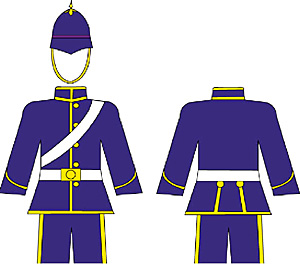 The Infantry
The Infantry
First established as the Metropolitan Rifles (two battalions) after the reorganisation of the Victorian Volunteer Rifles in the 1870s, the first battalion was renamed the First (West Melbourne) Battalion of Volunteer Rifles on the introduction of the Militia scheme of 1884.
The battalion took on more than ever before the look of contemporary British forces, including the blue, spiked helmet -influenced by the Prussian style - although with universal Victorian Forces helmet plate. The 1882 pattern field service equipment was worn along with the red coat and dark blue trousers with the red welt down the outside seam. They were armed with the trusty, Lee-Metford rifle.
The battalion was commanded by Lt-Col. Alfred Freeman whose headquarters were at Victoria Street in West Melbourne. At this time it consisted four companies "numbered" A-D, barracked in company barracks throughout the city two of which were at A'Beckett Street in the city and at Albert Park.
The Infantry tunic was faced blue at cuffs and collar. The closure of the tunic was edged with white piping.
The Cavalry and Nordenfelt Battery
The Victorian Cavalry was at this time the one surviving troop of the Prince of Wales Victorian Volunteer Light Horse, once a regiment of hussars, now re-mustering as part of the newly forming Victorian Mounted Rifles.
Formed in 1884 as The Nordenfelt Battery, this unit consisted initially of three Nordenfeldts intended to support the single cavalry squadron of the Victorian Cavalry.
Both units wore the rather plainer uniform of the Cavalry, that is to say a dark blue, single-breasted jacket and breeches with a cork sun helmet, likewise in dark blue or white in the summer months. Yellow piping was worn on the cuffs, closures and as a double stripe on the seam of the trousers. Equipment belts were white, swords scabbards were of steel with brass-hilted swords of the light cavalry pattern.
 The Artillery
The Artillery
The gunners at this time wore uniforms almost identical to those of their counterparts in the Imperial Forces. These were a dark-blue jacket and trousers with a small stand collar coloured red. Lace on the jacket followed the infantry pattern of arrangement being instead in red rather than white. Personal equipment was white.
There is photographic evidence of the artillerymen manning the fortifications were provided with a plain white working dress of brass buttoned white tunic with a low stand collar and white trousers. The same evidence suggests that the gunners regularly removed the jacket in warm weather and worked in their shirt-sleeves.
Gun carriages were a light blue-gray; iron-work was black.
The Torpedo corps wore a uniform identical to that of the Artillery, distinguished only by scarlet cuffs and their corps badges.
The Engineers
The Engineers wore a scarlet jacket with a blue collar and trousers.
Should anyone have any more details than this, I would be delighted were they to contact me at peleset@hotmail.com.
In the fourth and final part of this series, I will look at some possible scenarios for war gaming the defence of Melbourne.
To War? Part Three: The Victorian Military Forces
To War? What if the Russians Came? Part 1: Defending Melbourne in 1885 [H142]
To War? What if the Russians Came? Defending Melbourne in 1885 {H143]
- Part 2: Topography
Part 2: Fortifications and the Navy
Part 2: The Fleet
Part 2: Arms and Equipment: Guns
Part 2: Arms and Equipment: Ships
Back to The Heliograph # 147 Table of Contents
Back to The Heliograph List of Issues
Back to Master Magazine List
© Copyright 2005 by Richard Brooks.
This article appears in MagWeb.com (Magazine Web) on the Internet World Wide Web.
Other articles from military history and related magazines are available at http://www.magweb.com